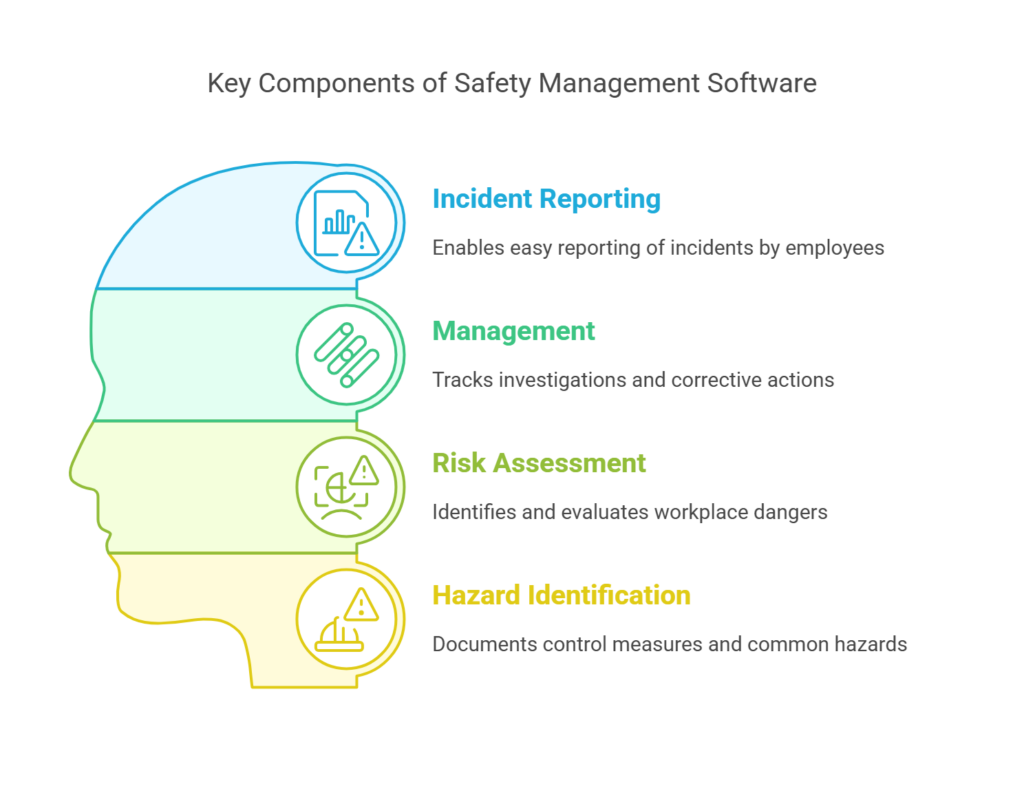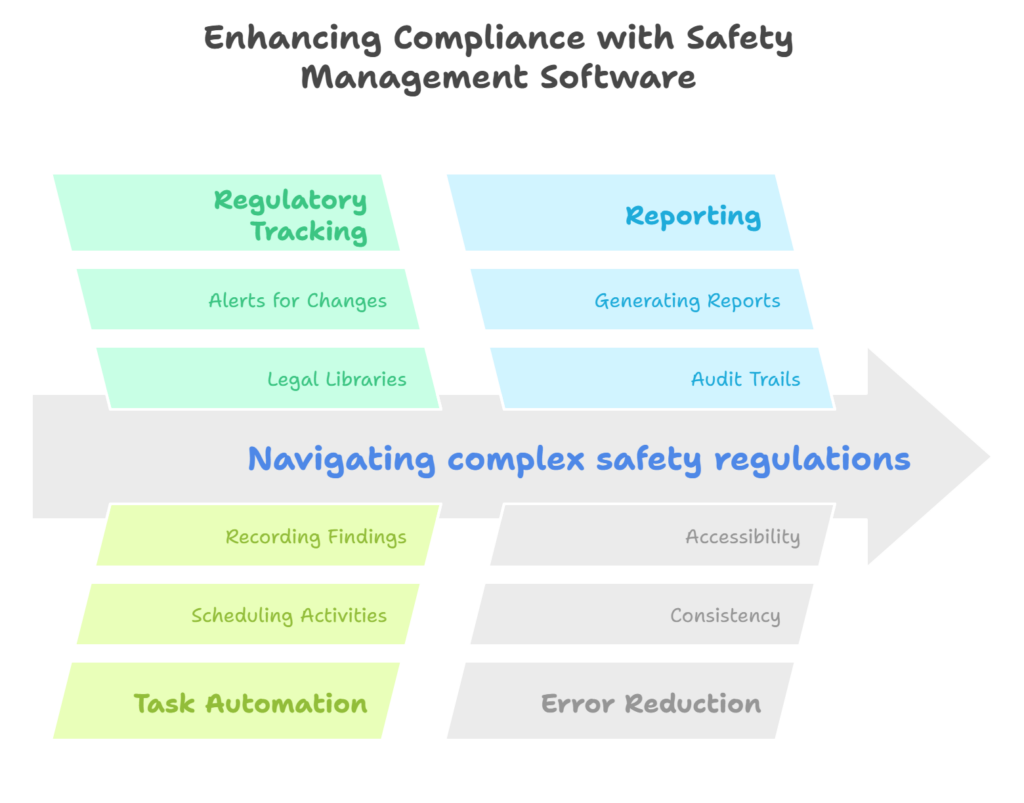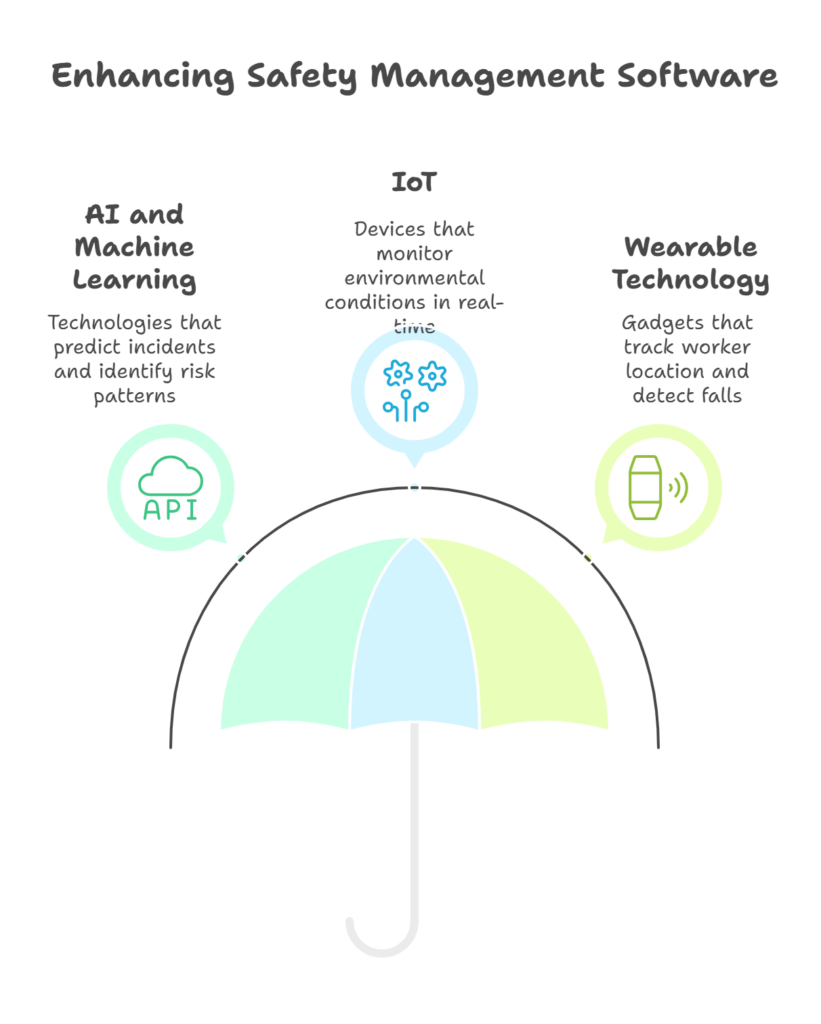Did you know that workplace injuries and illnesses cost businesses billions each year, not to mention the immeasurable human impact? 😥 Every incident, big or small, sends ripples through an organization. Thankfully, technology offers powerful tools to combat these risks. Safety management software has emerged as a crucial asset for companies committed to protecting their workforce and streamlining safety protocols.
Reading this piece will give you a clear picture of how these digital tools can revolutionize your approach to workplace safety. We’ll look at the core functions that make safety management software indispensable, explore the benefits like boosted efficiency and better compliance checks, and touch upon putting these systems into action effectively. Get ready to see how technology can foster a safer, more productive work environment. ✅
What is Safety Management Software?
At its heart, safety management software is a digital platform designed to help organizations manage their health and safety programs systematically. Its main purpose is to centralize safety-related information, automate key processes, and provide insights to prevent incidents before they happen. Think of it as a digital command center for all things safety, from tracking near-misses to managing safety training schedules.
Compared to old-school methods involving mountains of paperwork, overflowing filing cabinets, and hard-to-track spreadsheets, safety management software offers a leap forward. It replaces manual, often inconsistent processes with automated, standardized workflows. This digital approach makes information instantly accessible, reporting easier, and analysis much more powerful, paving the way for proactive safety improvements rather than just reactive responses. 📊
“Safety management software comprises digital solutions that help businesses facilitate the identification, assessment, and mitigation of potential risks and hazards.” -Noggin
Key Features of Safety Management Software
One of the most vital features is incident reporting and management. Good software makes it incredibly simple for any employee to report incidents, near-misses, or hazards directly from their computer or mobile device 📱. Once reported, the system tracks the investigation process, corrective actions assigned, and completion status, ensuring nothing falls through the cracks and valuable lessons are learned from every event.
Effective risk assessment and hazard identification tools are also central. These features allow safety professionals to systematically identify potential dangers in the workplace, evaluate the level of risk associated with them, and document control measures. Many platforms include customizable risk matrices and libraries of common hazards, speeding up the assessment process and promoting consistency across different sites or departments.

Keeping up with ever-changing safety regulations can be tough, which is where compliance tracking and reporting capabilities shine ✨. Safety management software often includes modules to monitor compliance with standards like OSHA, EPA, or ISO. It can help manage permits, schedule required inspections or audits, track training records, and generate reports needed to demonstrate compliance to regulators, saving significant time and reducing the risk of penalties.
“Key features include incident reporting, safety audits, environmental management, the ability to schedule safety meetings and training sessions, and much more.” -EHS Insight
Benefits of Implementing Safety Management Software
Switching to a digital safety management system often leads to a noticeable boost in efficiency and productivity. Automating tasks like report generation, action item tracking, and compliance checks frees up safety personnel from administrative burdens. This allows them to focus more time on proactive safety initiatives, like site inspections, worker training, and improving safety culture, rather than getting bogged down in paperwork. ⏱️
These platforms greatly improve communication and collaboration around safety issues. Having a central hub means safety data, reports, and action plans are accessible to relevant stakeholders in real-time. Dashboards can provide quick overviews, while automated notifications keep everyone informed about new incidents, assigned tasks, or upcoming deadlines. This transparency fosters better teamwork between departments and management. 🤝
Perhaps one of the biggest advantages is the ability to make data-driven decisions. Safety management software collects vast amounts of data on incidents, hazards, inspections, and training. Built-in analytics tools can process this data to reveal trends, identify root causes, and pinpoint high-risk areas or activities. These insights empower managers to allocate resources effectively and develop targeted prevention strategies based on solid evidence, not just guesswork. 🤔
Ultimately, investing in safety management software often results in significant cost reduction and a positive return on investment (ROI) 💰. By helping to prevent accidents and injuries, the software directly reduces costs associated with workers’ compensation claims, medical expenses, lost workdays, equipment damage, and potential fines. Improved efficiency and productivity also contribute to the bottom line, making safety a value driver for the business.
“By preventing accidents and minimizing insurance claims, workplace safety software delivers significant cost savings over the long term.” -My Field Audits
How Safety Management Software Ensures Compliance
Navigating the complex web of occupational health and safety regulations is a major challenge for many businesses. Safety management software simplifies this by providing tools to track applicable legal and regulatory requirements. Many systems maintain libraries of regulations that can be mapped to specific operations or locations, sending alerts when rules change or when compliance deadlines are approaching, helping organizations stay current.
A key strength lies in automating compliance-related tasks and reporting. The software can schedule recurring activities like safety audits, inspections, and equipment maintenance checks. It guides users through these processes, records findings, tracks corrective actions, and generates comprehensive reports in formats often required by regulatory bodies. This automation reduces errors, ensures consistency, and provides an easily accessible audit trail. 👍

“Safety management software simplifies compliance by automating regulatory processes, such as inspections, audits, and permit tracking.” -Noggin
Implementing Safety Management Software: Best Practices
Before jumping into a new system, it’s crucial to conduct a thorough needs assessment and set clear goals. What specific safety challenges are you trying to solve? Are you focused on improving incident reporting, streamlining audits, or better managing training records? Defining your objectives upfront helps ensure you select a system with the right capabilities and can measure success after implementation.
Choosing the right software solution involves looking beyond just features. Consider factors like ease of use, vendor support and training, integration capabilities with your existing systems, and scalability for future growth. Request demos, talk to references, and perhaps run a pilot program to see how the software performs in your actual work environment before making a final commitment.
Technology is only effective if people use it. Successful adoption hinges on comprehensive employee training and clear communication about the benefits of the new system. Focus on making the transition smooth, provide ongoing support, and highlight how the software makes safety tasks easier for everyone. Getting buy-in from frontline workers 👷♀️ and management is key to realizing the full potential of the software.
Real-World Applications of Safety Management Software
In the manufacturing sector, safety management software is used extensively. It helps manage lockout/tagout procedures for machine maintenance, track chemical inventories and safety data sheets (SDS), conduct regular equipment inspections, manage personal protective equipment (PPE) issuance, and analyze incident data to prevent recurring issues on the production floor.
Construction sites are inherently hazardous environments, making robust safety management critical. Software assists contractors in performing daily site safety briefings (toolbox talks), conducting site audits and inspections, managing permits for high-risk activities like confined space entry or hot work, tracking subcontractor safety performance, and ensuring compliance with site-specific safety plans. 🏗️ The construction sector benefits greatly from these tools.
Healthcare organizations also benefit greatly from safety management systems. They use the software to report and analyze patient safety incidents, manage infection control protocols, track environmental hazards, ensure compliance with healthcare regulations like HIPAA and Joint Commission standards, and manage staff safety training related to things like safe patient handling or dealing with hazardous materials.
Integrating Safety Management Software with Existing Systems
For maximum benefit, integrating safety management software shouldn’t operate in a silo. Integration with other core business systems, such as Human Resources (HR) platforms for employee data and training records, or Enterprise Resource Planning (ERP) systems for operational data, provides a more holistic view of safety performance and its connection to overall business operations.
Common integration challenges can include compatibility issues between different software APIs (Application Programming Interfaces) or difficulties in mapping data fields correctly. Working closely with software vendors, clearly defining integration requirements, and planning for data migration are important steps. Choosing software designed with integration in mind can simplify this process considerably.
The Role of Safety Management Software in Building a Safety Culture
Technology can play a powerful part in fostering a positive safety culture. When safety management software makes it easy for employees to report hazards, participate in inspections, or access safety information, it encourages greater engagement. Feeling that their input is valued and acted upon empowers workers to take ownership of safety in their areas.
The visibility and accountability provided by the software also contribute significantly to the overall safety culture. When safety performance metrics are tracked and shared, and when corrective actions are transparently managed, it sends a clear message that safety is a priority for the organization. This encourages a shift from a reactive, blame-focused approach to a proactive, learning-oriented safety mindset across all levels.
“Safety management software encourages employee participation and involvement in safety initiatives.” -Noggin
Future Trends in Safety Management Software
The future of safety management software looks exciting, particularly with the growing integration of Artificial Intelligence (AI) and machine learning 🤖. These technologies promise to analyze vast datasets to predict potential incidents before they occur, identify complex risk patterns invisible to human analysis, and automate more sophisticated decision-making processes for prevention.
The Internet of Things (IoT) and wearable technology also hold immense potential. Imagine sensors monitoring environmental conditions like air quality or noise levels in real-time, or wearables tracking worker location in hazardous zones or detecting falls. Integrating this data directly into safety management software will provide unprecedented levels of situational awareness and enable immediate responses to emerging risks. 📈

Choosing the Right Safety Management Software for Your Organization
When selecting a safety management software, several key factors warrant close consideration. Evaluate the specific features offered against your defined needs. Assess the user-friendliness of the interface – will your employees find it intuitive? Consider the total cost of ownership, including subscription fees, implementation costs, and training. Also, investigate the vendor’s reputation for customer support and reliability.
Think about your organization’s future needs. Choose a software solution that is scalable, meaning it can grow with your company and handle increasing amounts of data and users. Customization options are also important, as they allow you to adapt the software to your specific industry requirements, workflows, and reporting preferences, rather than forcing your processes to fit the software.
Cloud-based (SaaS – Software as a Service) solutions offer compelling advantages for many businesses. They typically require less upfront investment, are accessible from anywhere with an internet connection, and benefit from automatic updates and maintenance handled by the provider. Cloud platforms also often provide robust data security and backup measures, relieving your IT department of these burdens. ☁️
Nektar.io: A Comprehensive Safety Management Software Solution
Navigating the options for safety management support can seem complex, but partners like Nektar.io are here to help. Nektar.io provides expert services and potentially software solutions designed to streamline and bolster your company’s safety management processes. They focus on delivering tools and support that make safety tracking, reporting, and analysis straightforward and effective, helping you build a proactive safety environment.
Nektar.io helps businesses overcome common safety management hurdles like inefficient data collection, lagging indicator analysis, and compliance gaps. By offering tailored approaches and potentially user-friendly platforms, they empower organizations to move beyond basic compliance and cultivate a genuine culture of safety. Their services aim to give you the insights and control needed to protect your employees and improve operational performance. 💡
FAQ
What are the main components of a safety management system?
A typical safety management system (SMS), whether digital or not, usually includes four main components: Safety Policy (management commitment and goals), Safety Risk Management (hazard identification and risk control), Safety Assurance (monitoring performance and continuous improvement), and Safety Promotion (training, communication, and fostering a positive safety culture).
How does safety management software improve incident reporting?
It improves incident reporting by providing easy-to-use digital forms accessible via computers or mobile devices, standardizing the information collected, enabling real-time submission, automatically routing reports for investigation, and tracking corrective actions through to completion. This replaces slow, inconsistent paper-based methods.
Can safety management software be customized for specific industries?
Yes, absolutely. Many safety management software providers offer industry-specific modules or configurations (e.g., for construction, manufacturing, healthcare, oil & gas). Good software also allows for customization of forms, workflows, risk matrices, and reports to align with unique operational needs and terminology.
What is the ROI of implementing safety management software?
The Return on Investment (ROI) comes from various sources. Primarily, it stems from reducing the direct and indirect costs of workplace incidents (medical, compensation, lost time, property damage, fines). Additional ROI comes from improved operational efficiency, reduced administrative overhead, lower insurance premiums, and enhanced employee morale and productivity.
How does safety management software support regulatory compliance?
It supports compliance by centralizing regulatory requirements, tracking deadlines, automating compliance tasks like audits and inspections, managing training records, generating necessary reports for authorities, and maintaining an auditable trail of safety activities. This helps organizations stay prepared for inspections and avoid penalties.
Conclusion
In today’s workplaces, prioritizing safety isn’t just the right thing to do; it’s smart business. Safety management software provides the framework and tools necessary to effectively manage risks, ensure compliance, and boost overall efficiency. By moving away from cumbersome manual processes towards integrated digital solutions, companies can protect their most valuable asset – their people – more effectively than ever before.
If you’re looking to strengthen your safety programs and foster a culture where everyone goes home safe 🏡, consider exploring the services offered by Nektar.io. They provide comprehensive support and potentially software solutions designed to meet modern safety challenges head-on, helping you enhance workplace protection and achieve operational excellence. Reach out to Nektar.io to learn how they can assist with your safety management needs!
Key Takeaways:
- Safety management software significantly improves workplace safety and efficiency
- Key features include incident reporting, risk assessment, and compliance tracking
- Implementing safety software leads to cost savings and improved safety culture
- Nektar.io offers a comprehensive solution for organizations seeking to enhance their safety management


